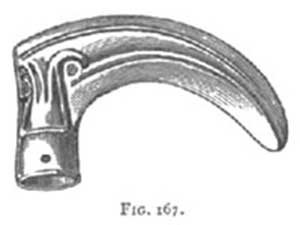Land, Crops, and Tillage in Ancient Ireland
From A Smaller Social History of Ancient Ireland 1906
« previous page | contents | start of chapter | next page »
CHAPTER XIX....continued
2. Land, Crops, and Tillage.
Classification of Land.—Land was carefully classified in the Brehon Law for the purpose of fixing prices: there being three divisions of "superior or good arable land," and three of "weak arable land."
Manure (Irish ottrach) is very often mentioned in the Laws, showing the importance attached to it. The manure mentioned in the Brehon Law was chiefly stable-manure: and a law-tract mentions also the application of shells to land to improve it. This last tract, following old custom, enumerates eleven different things that add to the value of land, and estimates in séds or cows the amount added by each. Of these the most important are:—a wood properly fenced in: a mine of copper or iron: the site of an old mill [with millrace and other accessories, rendering easy the erection of a new mill]: a road [opening up communication]: situation by the sea, by a river, or by a cooling pond for cattle.
Digging for Water.—Various passages both in the Brehon Laws and in general Irish literature show that the ancient Irish understood the art of obtaining water by digging deeply into the ground. It must have been a pretty common practice moreover, for the annalists assign a legendary origin for it, a thing they never did except where the custom was general. The Four Masters say, under A.M. 3991: "It was by this king (Fiacha) that the earth was first dug in Ireland in order that water might be in wells." The Greeks similarly assigned the origin of their custom of digging for water to their old hero Danaus, king of the Argives.
Crops.—Most of the native crops now in use were then known and cultivated: chief among them being corn of various kinds. Corn in general was denoted by the words arbar [arvar or arroor] and ith [ih]; besides which there was a special name for each kind. We know for a certainty that wheat (Irish cruithnecht, pron. crunnat) has been cultivated in this country from the most remote ages; for we find it constantly mentioned in our ancient literature: of which an interesting illustration will be found in the record of the death of the two princes in Mailoran's mill at p. 457, below. So also as to oats (Irish coirce, pron. curkh-ya); numerous references to its cultivation and use are found in our most ancient literature.
In modern times, before the potato became very general, oats formed one of the principal articles of food of the people, as it did of old. Barley (Irish eórna [orna]) and rye (Irish segal, pron. shaggal) were cultivated, and formed an important part of the food supplies.
FIG. 167. Ancient Irish bronze reaping hook: of beautiful workmanship, 6 ¼ inches long. It was fitted with a handle, which was fastened in the socket with a rivet. In the National Museum, Dublin. (Wilde's Catalogue).
Corn was cut with a sickle or reaping-hook, anciently called serr or searr [sharr]; but the present name is carrán. Many specimens of reaping-hooks have been found in Ireland, some of bronze and some of iron, which may be seen in the National Museum in Dublin. They are all small, and cutting with them must have been slow work. Those of bronze are very ancient—probably beyond the reach of history. The iron ones are hardly so old; but still they have the look of great antiquity. Meadow-grass was cut with a scythe anciently and still called speal [spal].
The corn while in sheaves was stacked in a haggard, which was called ithlann, 'corn-yard.' The rick (Ir. cruach) was commonly covered with thatch, twined or woven with ropes to protect it from wind and rain. The sheaves were threshed with a súist or flail, as at present.
Farm Implements.—Most of the common implements employed in farm-work at the present day were used by the ancient Irish, though no doubt they were somewhat different in make. The use of the plough was universal. The old word for it was arathar [arraher], but it is now called céchta [kaighta], which is also an ancient word. Several of the parts of the plough are mentioned in the old records. The iron coulter or ploughshare was called socc, which is the word still used. The plough was generally drawn by oxen: but sometimes by horses. The ploughman had each ox held by a halter, and he also carried a sharp goad (Irish brot), "so that"—as the law tract expresses it—"the ox may be mastered."
For breaking clods of clay in a ploughed field farmers used a clod-mallet called forcca or farcha, which means a mallet of any kind: it had a wooden handle, the head being also made of wood. They used a spade (rama) and a shovel (sluasat), both fixed on wooden handles and both probably made of iron. In Cormac's Glossary the word for a spade is fec, which is still in use even among the English-speaking people of many parts of Ireland, who call a spade feck or fack. Rama and sluasad are also retained as living words for spade and shovel: but the former takes the diminutive form ramhan, often shortened to rán, both pronounced rawn. A rake was used, which, as far as we can judge from the description of it given in Cormac's Glossary, must have been much the same as that used at present. It is called in the Glossary rastal, which is the present name.

